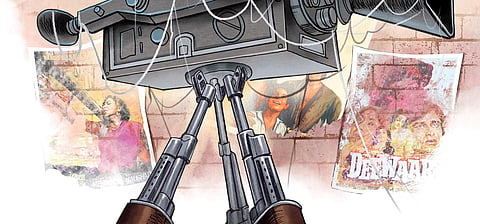

April 9 this year will be an important landmark for Manipuri cinema. That is the day this art form will enter its 50th year of existence since the first full-length Manipuri feature film, Matamgi Manipur, was released in 1972. Much water has flowed down the many rivers of Manipur ever since and today the art form is again facing a unique challenge, demanding for it to reinvent itself yet again. This battle cannot be left to those directly involved in the industry alone, for no art can flourish without patronage of an enlightened audience. It is therefore important for efforts to be made to create the right atmosphere for the emergence of a discerning and critical audience.
One of the major hurdles for this is the slow but certain withering away of cinema theatres in the state, triggered by the banning of Hindi films about 20 years ago by an underground militant group with the stated intent of saving Manipur’s indigenous cultures from overly excessive influence from a more dominant culture that Hindi represented. However, Manipur’s market for films being small, this resulted in its shrinking below sustainability and in the course of the decades since, most cinema houses have had to shut, depriving what is described as “box office” revenue for those in films. This obviously was a harsh blow for the state’s fledgling film industry.
One is reminded here of a phenomenon in the natural world that environmentalists have come to term as “trophic cascades”, an ecological regeneration that begins at the top of the food chain. It says, contrary to popular belief, predators have a vital function in keeping an ecosystem healthy. This was demonstrated dramatically at the Yellowstone National Park in the US. Wolves in this park had once been eliminated but although the population of their prey, deer in particular, multiplied, the ecosystem deteriorated rather than improved. A few decades ago, wolves were reintroduced in the park and the changes this brought about was stunning. Deer retreated higher into the hills where escape from the wolves was easier, and in turn grasses and shrubs in the plains got greener, soil retained water better, rivers and stream became more perennial, trees got greener and the fruits they began bearing brought back birds, which in turn helped seed dispersal and a whole chain of cascading consequences began unfolding, ultimately restoring the natural health of the park. It needs to be considered whether there is a lesson in this for Manipur’s film industry.
Cinema houses disappearing has had consequences other than the slow death of “box offices”. It has also changed the profile of the cinema audience. This is especially so after the advent of the digital age. Today, a great many cinema lovers watch their movies on digital devices such as smartphones, tablets, computers, TV screens, etc. This is obviously convenient but not without drawbacks, the foremost of which is the level of audience engagement. Unlike going for a movie in a cinema theatre, it is impossible for the audience to suspend disbelief and enter the fictional world that any particular film explores. Hence, a person watching 3D films like Life of Pi, Gravity or Avatar in a theatre can, for the duration of the movie, immerse themselves totally into the ecosystem of the drama these movies create and hence not just see but feel the actions and emotions. On a smartphone, this is seldom possible. The phone may begin ringing, somebody may request a small errand, etc. In all likelihood, the person may end up putting the drama on pause to continue watching another time. This lack of audience engagement would quite expectedly water down the critical faculty of the viewers, which in turn would affect the quality of the cinema produced, for indeed, any good art involves a serious dialectics between audience and artist. Cinema, after all, is a form of communication. No good art can be created out of nothing; it is on the other hand a creative and unique response to a given social circumstance.
There is yet another mind block that Manipuri cinema has to overcome. There are still some people nostalgic about the celluloid era and think returning to it can improve the quality of cinema in the state. Nothing can be farther from the truth and therefore the quicker the thought is abandoned, the better it would be. Nobody can avoid the future and let there be no doubt whatsoever at this point that digital is the future. Other than its exponentially greater technological capabilities, it has also made film-making accessible to anybody with a passion for it. True, the explosion in the number of filmmakers outside of the elite circle that once monopolised this art and trade during the celluloid days can and probably has brought down the standard of films generally, but ultimately a cream would emerge from among them and that is what everybody should be interested in. Let it not be forgotten that the wider the base from which to draw this cream, the more of it there would be.
Pradip Phanjoubam
Editor, Imphal Review of Arts and Politics
(phanjoubam@gmail.com)